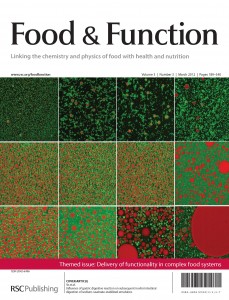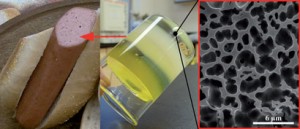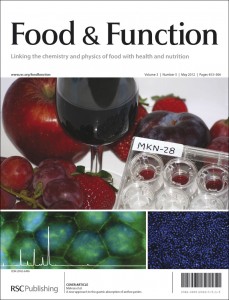 Food & Function issue 5 is online now. The front cover highlights work from Nuno Mateus and co-workers from the University of Porto in Portugal. Their paper ‘A new approach on the gastric absorption of anthocyanins’ investigates the absorption of anthocyanins in the stomach using a novel in vitro cell model. You can read this article free for 6 weeks by clicking here.
Food & Function issue 5 is online now. The front cover highlights work from Nuno Mateus and co-workers from the University of Porto in Portugal. Their paper ‘A new approach on the gastric absorption of anthocyanins’ investigates the absorption of anthocyanins in the stomach using a novel in vitro cell model. You can read this article free for 6 weeks by clicking here.
The issue also has three reviews; Akira Murakami and Kohta Ohnishi from Kyoto University in Japan discuss the current status and future directions of research related to target molecules of food phytochemicals. Joanne Slavin from the University of Minnesota and co-workers from the USA review ‘The confusing world of dietary sugars’. Advisory Board member Leif H. Skibsted from the University of Copenhagen and co-workers from the University of São Paulo review ‘riboflavin as a photosensitizer’, looking at the ‘mechanistic aspects of light-induced changes in food and tissues sensitized by riboflavin’.
The issue also contains a communication from Srinivas Janaswamy and Susanne R. Youngren from Purdue University which has received extensive coverage in the media. Their communication entitled ‘Hydrocolloid-based nutraceutical delivery systems’ demonstrates a novel method for the delivery of nutraceuticals using the thermal protection of ordered hydrocolloid matrices. Read the Chemistry World article on this paper here.
You can keep up to date with the latest developments from Food & Function by signing up for free table of contents alerts and monthly e-newsletters.












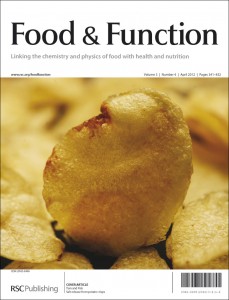
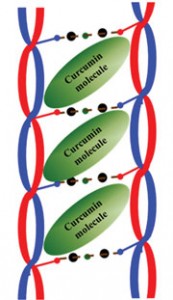
![Butter_and-_Milk_shutterstock_39279025[1]_250_tcm18-215194 Butter and Milk](https://blogs.rsc.org/fo/files/2012/03/Butter_and-_Milk_shutterstock_392790251_250_tcm18-215194.jpg)
 Food & Function Issue 3 is now online and is a themed issue on research presented at the Delivery of Functionality in Complex Food Systems Symposium which was held in Guelph, Canada, in August 2011.
Food & Function Issue 3 is now online and is a themed issue on research presented at the Delivery of Functionality in Complex Food Systems Symposium which was held in Guelph, Canada, in August 2011. 